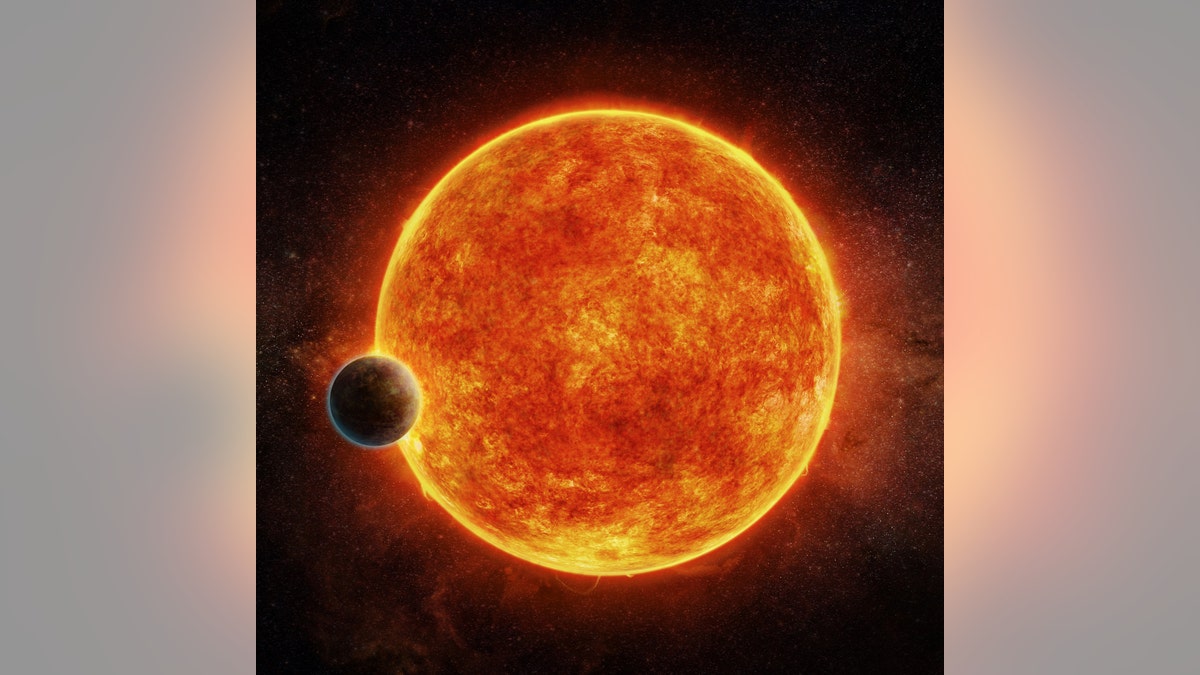
This planet is located in the liquid water habitable zone surrounding its host star, a small, faint red star named LHS 1140. The planet weighs about 6.6 times the mass of Earth and is shown passing in front of LHS 1140. Depicted in blue is the atmosphere the planet may have retained. (M. Weiss/CfA)
An exoplanet 40 light-years from Earth may be the best place to look for signs of life outside our Solar System, scientists say.
An international team of astronomers used the European Southern Observatory’s High Accuracy Radial velocity Planet Searcher (HARPS) in La Silla, Chile and other telescopes around the world to discover the so-called “super Earth” LHS 1140b, which orbits the faint star LHS 1140.
A light year, which measures distance in space, equals 6 trillion miles.
ASTRONOMERS DISCOVER 60 NEW WORLDS, FIND 'SUPER EARTH'
Scientists are excited by the prospects for life on LHS 1140b.
“What we think is so significant about this planet is that not only is it at the right distance from its host star that we think that liquid water and possibly oceans can exist on its surface, but also this star is only 40 light years away which is incredibly close,” Jason Dittmann of the Harvard-Smithsonian Center for Astrophysics, told Fox News, via email. “If we shrank the entire Galaxy to the size of the United States, the distance between the Earth and this planet would be smaller than Central Park. So this planet is really Earth's next door neighbor.”
Dittmann, who is lead author on a study detailing the discovery, explained that LHS 1140 is a “very quiet” star, which bodes well for conditions on LHS 1140b. “We don't see (LHS 1140) giving off lots of high energy flares which might harm the planet's atmosphere or anything on its surface,” he wrote. “So it could potentially be a very stable nice place.”
The study was published in the journal Nature on Thursday.
'SUPERFLARES' LIKELY MADE PROXIMA B UNINHABITABLE LONG AGO
LHS 1140b was first identified by the MEarth project, which searches for exoplanets using the Fred Lawrence Whipple Observatory (FLWO) on Mount Hopkins, AZ. and the Cerro Tololo Inter-American Observatory (CTIO) on Cerro Tololo, Chile. Astronomers noticed dips in light as LHS 1140b passed in front of LHS 1140.
Scientists then harnessed the HARPS instrument to make follow-up observations, confirming the presence of the super-Earth and its 25-day orbital period around LHS 1140. Astronomers estimate that the planet is at least five billion years old with a diameter 1.4-times larger than Earth. However, LHS 1140b’s mass is thought to be seven times greater than Earth, which could indicate the exoplanet is solid with a dense iron core.
“Our new planet is a temperate, rocky planet orbiting a small star with very little activity (flares, winds or UV radiation),” Xavier Bonfils, an astrophysicist at the Institut de Planétologie et d'Astrophysique de Grenoble (IPAG), and the Centre National de la Recherche Scientifique (CNRS) in France, who participated in the study, told Fox News. Set against this backdrop, scientists are hopeful that the exoplanet has retained its atmosphere.
7 NEW EARTH-LIKE EXOPLANETS DISCOVERED, NASA ANNOUNCES
This is the latest in a string of exciting space discoveries.
Last year, for example, the discovery of Earth-like planet Proxima b, which is about 4 light years from Earth, was announced. Earlier this year, NASA announced the discovery of seven Earth-sized planets orbiting the star TRAPPIST-1, nearly 40 light years away from Earth.
Also this year, astronomers announced the discovery of 60 new planets orbiting stars close to Earth’s solar system, including another “super Earth.” The 60 new planets are orbiting stars that are mostly some 20 to 300 light years away.
Bonfils and his fellow CNRS and IPAG scientist Xavier Delfosse think that LHS 1140b may be the best candidate yet for future observations to study its atmosphere, if one exists. “The LHS 1140 system might prove to be an even more important target for the future characterisation of planets in the habitable zone than Proxima b or TRAPPIST-1,” they wrote, in a statement.
FOR THE LATEST TECH FEATURES FOLLOW FOX NEWS TECH ON FACEBOOK
Dittmann told Fox News that LHS 1140b will be close enough to the James Webb Space Telescope and the Giant Magellan Telescope could potentially detect oxygen in its atmosphere. “If we can do that, it would potentially be very exciting, because Oxygen is the gas that we breath and so we're relentless pursuing and trying to detect more and more things that might make this planet look like a piece of home on the Earth,” he said.
The James Webb Space Telescope launches next year. The Giant Magellan Telescope is expected to be completed in 2025.
Experts from a host of organizations participated in the research, including MIT, Caltech and the University of Colorado.
Follow James Rogers on Twitter @jamesjrogers
